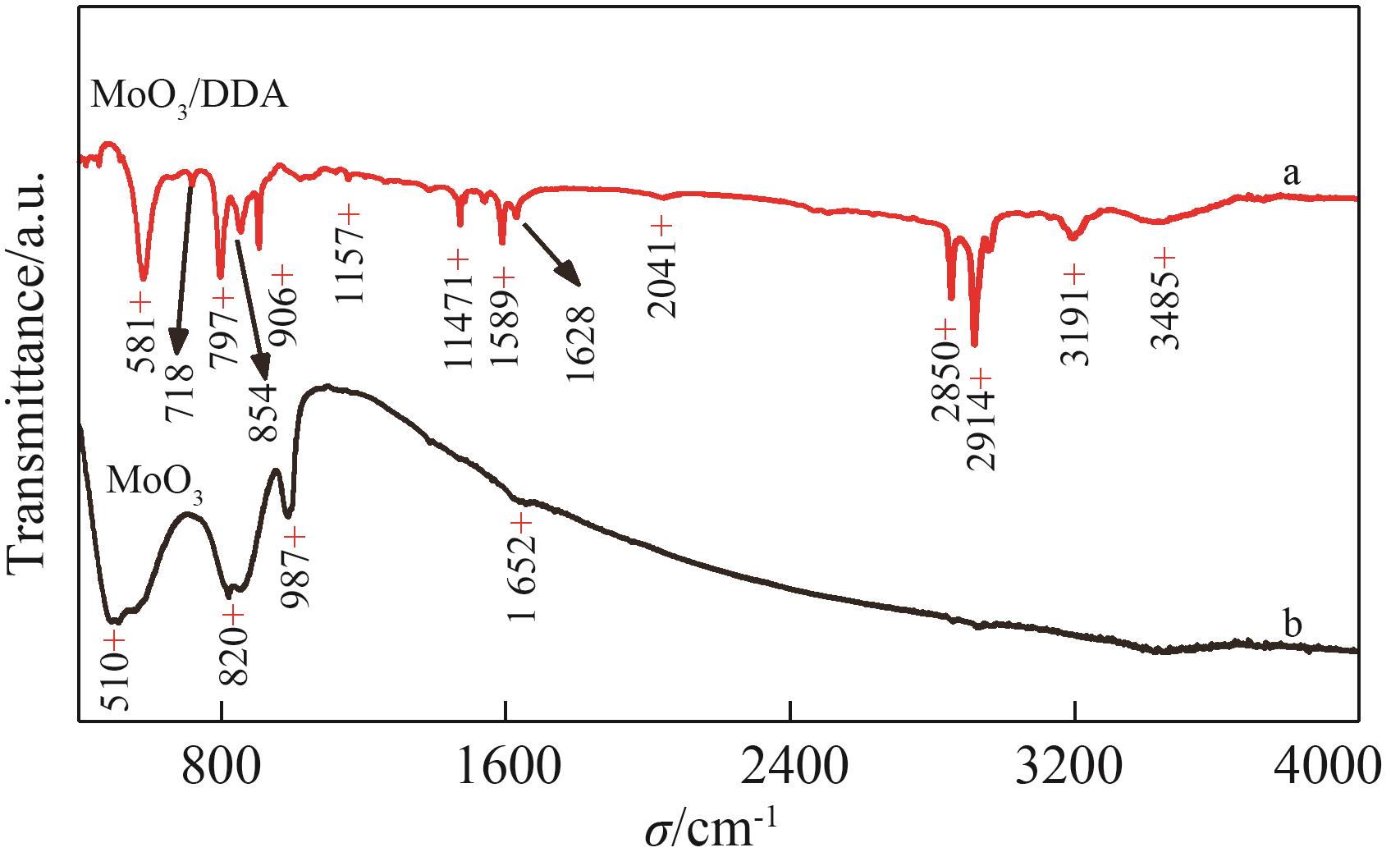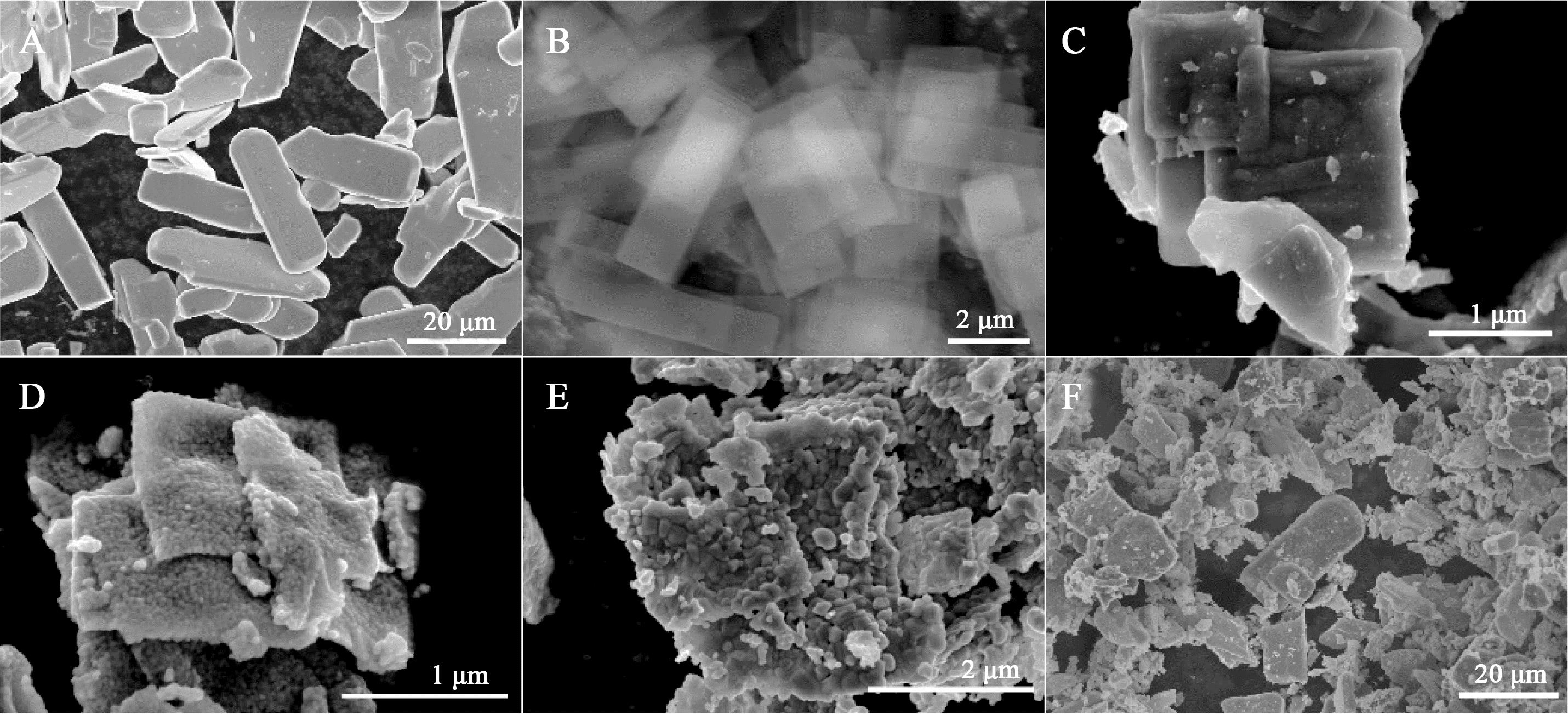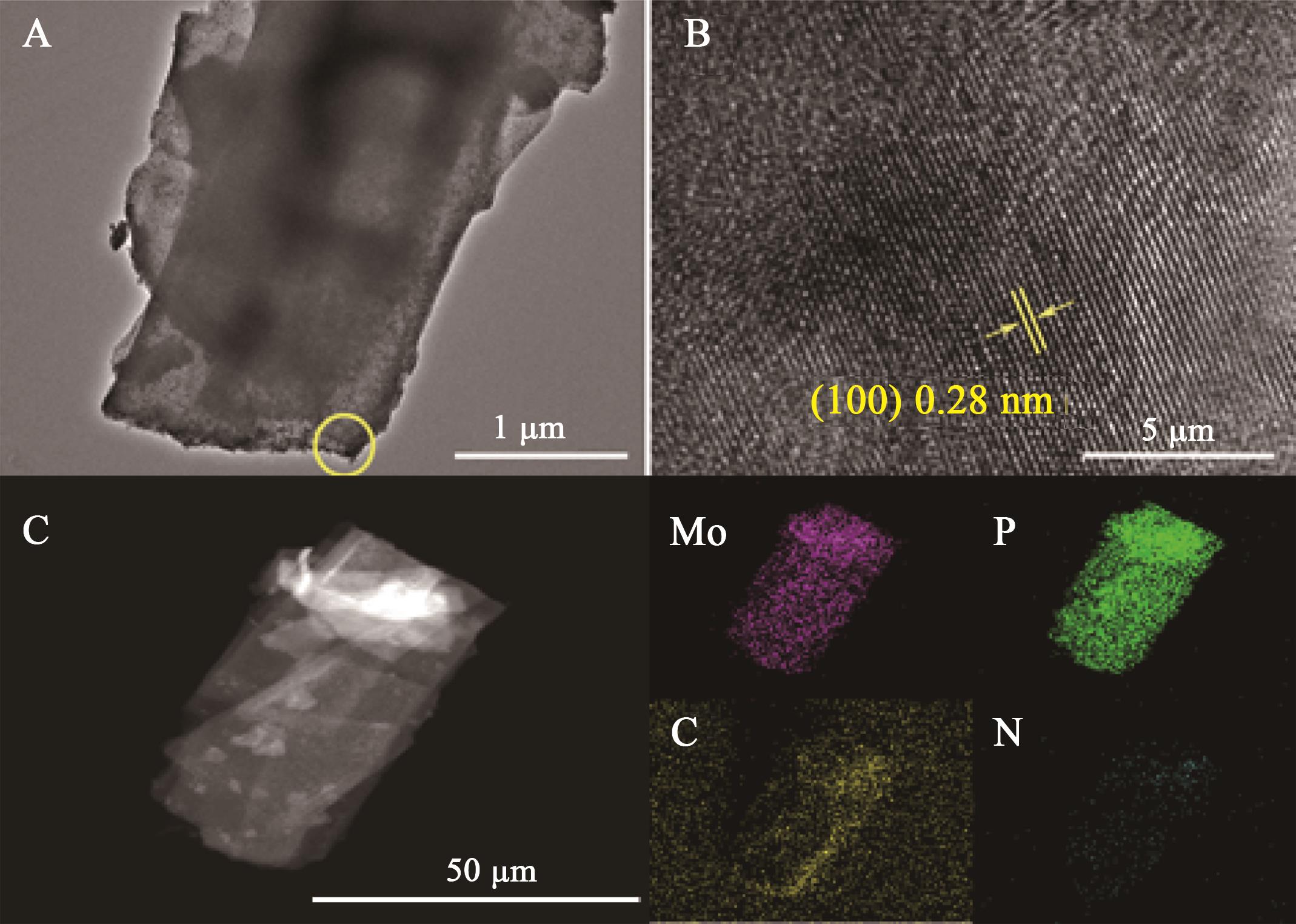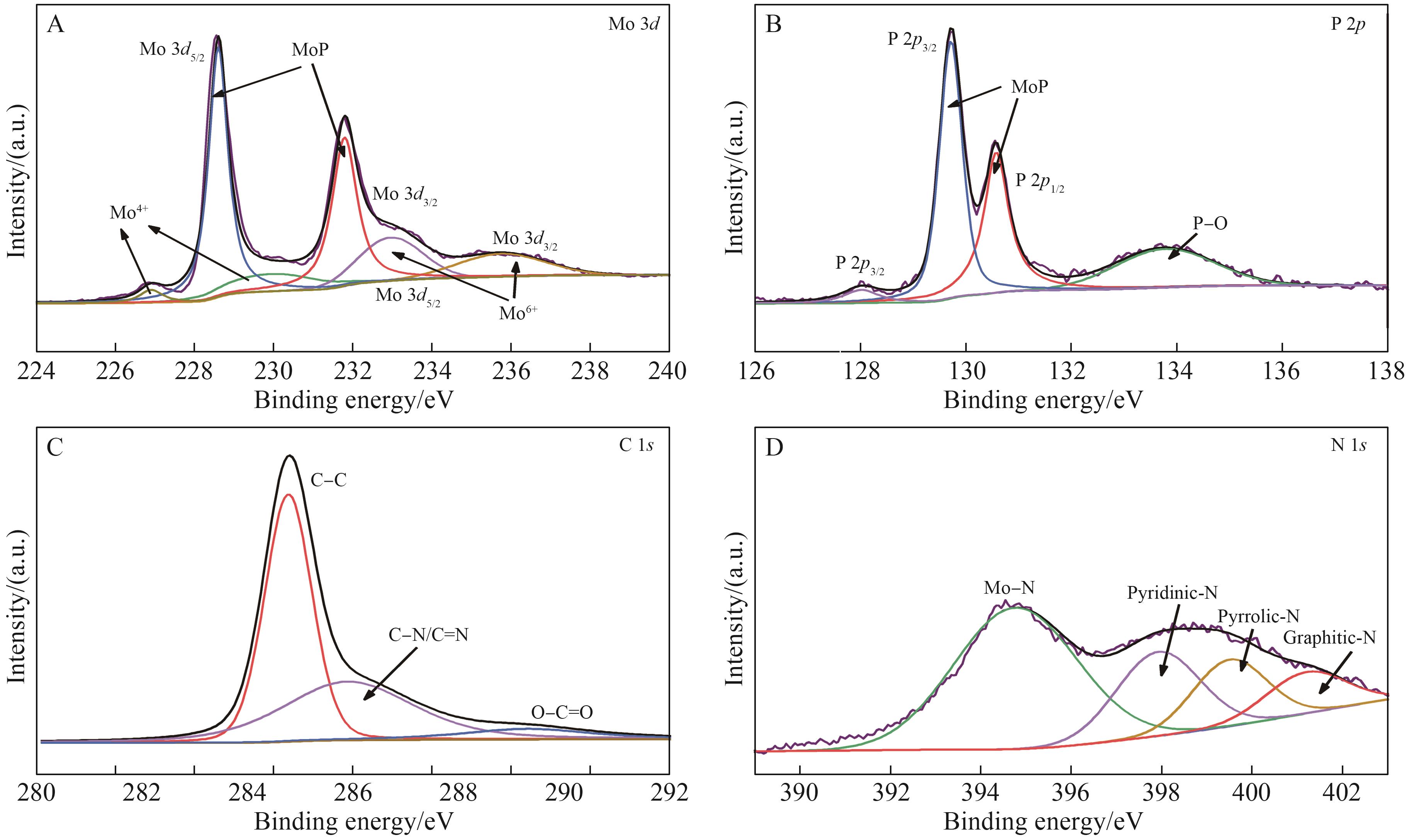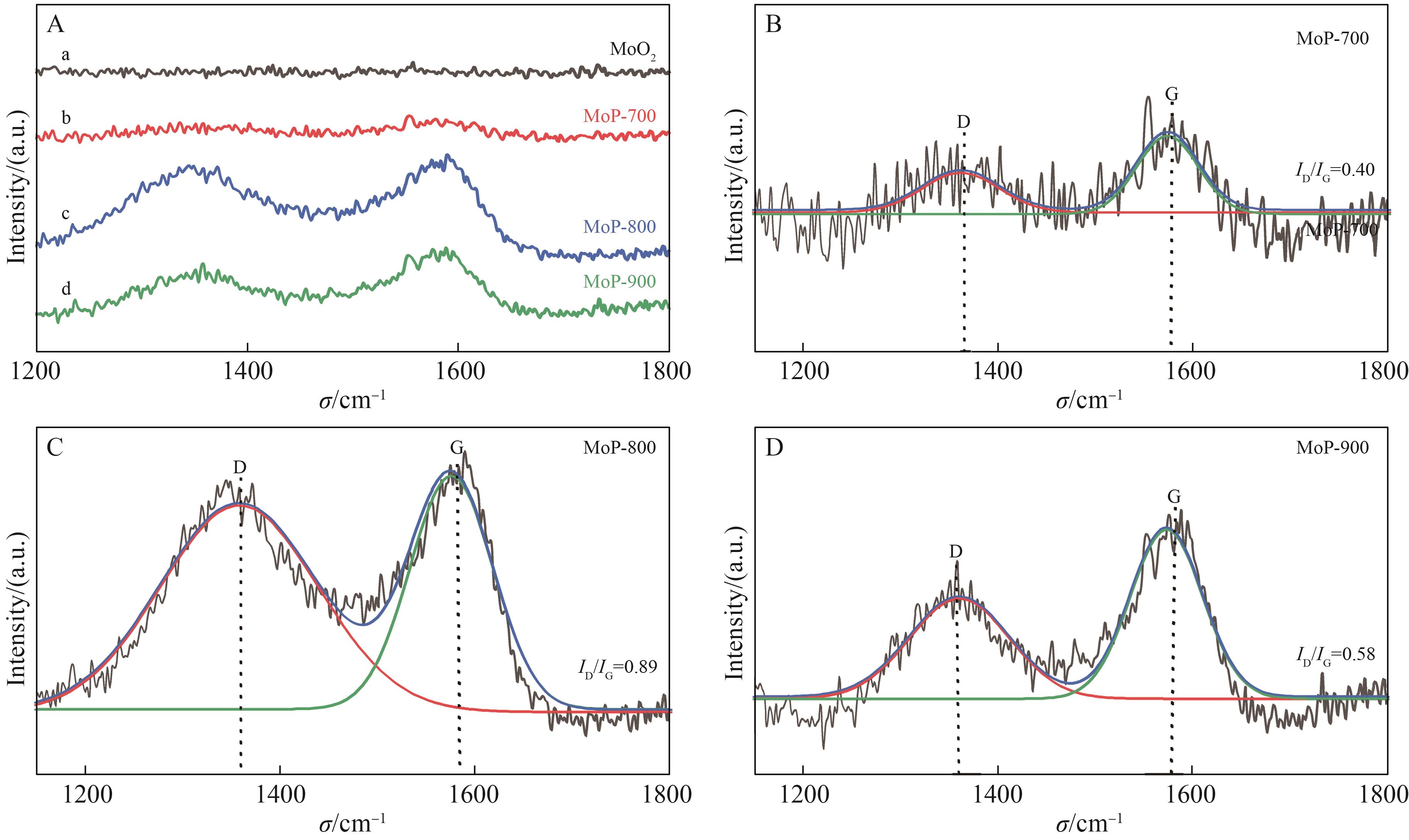
Chinese Journal of Applied Chemistry ›› 2022, Vol. 39 ›› Issue (3): 439-450.DOI: 10.19894/j.issn.1000-0518.210086
• Full Papers • Previous Articles Next Articles
Preparation of Molybdenum Phosphide⁃based Catalyst and Its Application in Water Electrolysis
Bo-Yang CUI, Hong-Da WU, Zong-Bao YU, Zong-Xing GENG, Tie-Qiang REN, Chun-Wei SHI, Zhan-Xu YANG( )
)
- School of Petrochemical Engineering,Liaoning Petrochemical University,Fushun 113001,China
-
Received:2021-03-01Accepted:2021-06-23Published:2022-03-01Online:2022-03-15 -
Contact:Zhan-Xu YANG -
About author:zhanxuy@126.com
-
Supported by:the National Natural Science Foundation of China(21671092);Liaoning Provincial Science and Technology Innovation Leading Talent Project(XLYC1802057);the Joint Research Fund of Liaoning?Shenyang National Laboratory for Materials Science, China(2019010280?JH3/301);Fushun Youth Talents Project(FSYC202007001)
CLC Number:
Cite this article
Bo-Yang CUI, Hong-Da WU, Zong-Bao YU, Zong-Xing GENG, Tie-Qiang REN, Chun-Wei SHI, Zhan-Xu YANG. Preparation of Molybdenum Phosphide⁃based Catalyst and Its Application in Water Electrolysis[J]. Chinese Journal of Applied Chemistry, 2022, 39(3): 439-450.
share this article
Add to citation manager EndNote|Ris|BibTeX
URL: http://yyhx.ciac.jl.cn/EN/10.19894/j.issn.1000-0518.210086
样品 Samples | 氮元素含量 X(N)/% | 碳元素含量 X (C)/% |
|---|---|---|
| MoP?700 | 0.497 | 3.370 |
| MoP?800 | 0.447 | 3.638 |
| MoP?900 | 0.416 | 3.068 |
Table 1 The nitrogen and carbon content of the catalyst
样品 Samples | 氮元素含量 X(N)/% | 碳元素含量 X (C)/% |
|---|---|---|
| MoP?700 | 0.497 | 3.370 |
| MoP?800 | 0.447 | 3.638 |
| MoP?900 | 0.416 | 3.068 |

Fig.7 N2 adsorption-desorption isotherms of MoP-700, MoP-800, MoP-900 and MoO2 (A); Pore size distribution curves of MoP-700, MoP-800, MoP-900and MoO2 (B)

Fig.8 Electrochemical test results of MoP-700, MoP-800, MoP-900 and MoO2: Polarization curves(A); Tafel plots (B); Nyquist plots (C); Cdl of different materials (D); Electrolysis curve of MoP-800 at a fixed current of -10 mA for more than 27 h (E); The stability test of MoP-800 with an initial LSV curve and after 1000 cycles (F)
催化剂 Catalysts | 电解液 Electrolyte | 过电势 η10/(mA·cm-2) | 塔菲尔斜率 Tafel slope/(mV·dec-1) | 参考文献 Ref. |
|---|---|---|---|---|
| MoP?RGO | 0.5 mol/L H2SO4 | 117 | 62 | |
| MoP@C@rGO | 0.5 mol/L H2SO4 | 168.9 | 79 | |
| MoP@NPC?S | 0.5 mol/L H2SO4 | 141 | 61 | |
| MoP/NPG | 0.5 mol/L H2SO4 | 148 | 49 | |
| MoP/Mo2N | 0.5 mol/L H2SO4 | 89 | 51 | |
| CoMoP | 0.5 mol/L H2SO4 | 39 | 73.3 | |
| MoC?MoP/BCNC | 0.5 mol/L H2SO4 | 158 | 58 | |
| MoP/Co2P | 0.5 mol/L H2SO4 | 140 | 80 | |
| HF?MoSP?800 硫化钼/磷化钼复合材料 | 0.5 mol/L H2SO4 | 108 | 82 | |
MoP/N掺杂石墨 MoP/N doped graphite | 0.5 mol/L H2SO4 | 111 | 70 | 本文 This work |
Table 2 Comparison of HER parameters of several molybdenum phosphide catalysts
催化剂 Catalysts | 电解液 Electrolyte | 过电势 η10/(mA·cm-2) | 塔菲尔斜率 Tafel slope/(mV·dec-1) | 参考文献 Ref. |
|---|---|---|---|---|
| MoP?RGO | 0.5 mol/L H2SO4 | 117 | 62 | |
| MoP@C@rGO | 0.5 mol/L H2SO4 | 168.9 | 79 | |
| MoP@NPC?S | 0.5 mol/L H2SO4 | 141 | 61 | |
| MoP/NPG | 0.5 mol/L H2SO4 | 148 | 49 | |
| MoP/Mo2N | 0.5 mol/L H2SO4 | 89 | 51 | |
| CoMoP | 0.5 mol/L H2SO4 | 39 | 73.3 | |
| MoC?MoP/BCNC | 0.5 mol/L H2SO4 | 158 | 58 | |
| MoP/Co2P | 0.5 mol/L H2SO4 | 140 | 80 | |
| HF?MoSP?800 硫化钼/磷化钼复合材料 | 0.5 mol/L H2SO4 | 108 | 82 | |
MoP/N掺杂石墨 MoP/N doped graphite | 0.5 mol/L H2SO4 | 111 | 70 | 本文 This work |
| 1 | HOSSEINI S E, WAHID M A. Hydrogen from solar energy: a clean energy carrier from a sustainable source of energy[J]. Int J Energy Res, 2019, 44(7): 4110-4131. |
| 2 | MCCRORY C C L, JUNG S, FERRER I M, et al. Benchmarking hydrogen evolving reaction and oxygen evolving reaction electrocatalysts for solar water splitting devices[J]. J Am Chem Soc, 2015(137): 4347-4357. |
| 3 | ZHANG H, LIU Y, WU H, et al. Open hollow Co-Pt clusters embedded in carbon nanoflake arrays for highly efficient alkaline water splitting[J]. J Mater Chem A, 2018, 6(41): 20214-20223. |
| 4 | LI J S, KONG L X, WU Z, et al. Polydopamine-assisted construction of cobalt phosphide encapsulated in N-doped carbon porous polyhedrons for enhanced overall water splitting[J]. Carbon, 2019, 145: 694-700. |
| 5 | YANG J Z, YU Z B, SUN W, et al. Efficient electrocatalytic performance of WP nanorods propagated on WS2/C for hydrogen evolution reduction[J]. ChemElectroChem, 2020, 7(14): 3082-3088. |
| 6 | DU J, WU H, WANG X, et al. Ternary MoS2/MoO3/C nanosheets as high-performance anode materials for lithium-ion batteries[J]. J Electron Mater, 2018, 47(11): 6767-6773. |
| 7 | 蒙阳, 杨婵, 彭娟. 基于铁、钴、镍金属磷化物纳米催化剂的碱性条件下电解水制氢的研究进展[J]. 应用化学, 2020, 37(7): 733-745. |
| MENG Y, YANG C, PENG J. Progress in iron, cobalt and nickel-based metal phosphide nano-catalysts for hydrogen production under alkaline conditions[J]. Chinese J Appl Chem, 2020, 37(7): 733-745. | |
| 8 | 于鹏, 李景虹. 硫(磷)化物用于电化学析氢反应[J]. 应用化学, 2018, 35(9): 1093-1101. |
| YU P, LI J H. Metal sulfide (phosphide) for electrocatalytic hydrogen evolution reaction[J]. Chinese J Appl Chem, 2018, 35(9): 1093-1101 | |
| 9 | LIU X, LU S X, XU H H, et al. Effects of polyethylene glycol and Cctric acid on preparation and hydrodechlorination activity of molybdenum phosphide[J]. Russ J Phys Chem A, 2018, 92(7): 1274-1278. |
| 10 | CHEN X, WANG D, WANG Z, et al. Molybdenum phosphide: a new highly efficient catalyst for the electrochemical hydrogen evolution reaction[J]. Chem Commun, 2014, 50(79): 11683-11685. |
| 11 | DU H, KONG R M, GUO X, et al. Recent progress in transition metal phosphides with enhanced electrocatalysis for hydrogen evolution[J]. Nanoscale, 2018, 10(46): 21617-21624. |
| 12 | GE R, HUO J, LIAO T, et al. Hierarchical molybdenum phosphide coupled with carbon as a whole pH-range electrocatalyst for hydrogen evolution reaction[J]. Appl Catal B: Environ, 2019, 260: 118196. |
| 13 | GUO S,TAN W, QIU J, et al. Classification of spatially confined reactions and the electrochemical applications of molybdenum-based nanocomposites[J]. Aust J Chem, 2020, 73(7):578-600. |
| 14 | ZHUANG Z, LI Y, LI Z, et al. MoB/g-C3N4 interface materials as a Schottky catalyst to boost hydrogen evolution[J]. Angew Chem, 2018, 57(2): 496-500. |
| 15 | JING Y, PAN Q, CHENG Z, et al. Direct thermal intercalation of amine into layered MoO3[J]. MSEB, 2007, 138(1): 55-59. |
| 16 | QIU J, YANG Z, LI Y. N-doped carbon encapsulated ultrathin MoO3 nanosheets as superior anodes with high capacity and excellent rate capability for Li-ion batteries[J]. J Mater Chem A, 2015, 3(48): 24245-24253. |
| 17 | LALIK E, DAVID W I F, BARNES P, et al. Mechanisms of reduction of MoO3 to MoO2 reconciled?[J]. J Phys Chem B, 2001, 105(38): 9153-9156. |
| 18 | LI J S, ZHANG S, SHA J Q, et al. Confined molybdenum phosphide in P-oped porous carbon as efficient electrocatalysts for hydrogen evolution[J]. ACS Appl Mater Interfaces, 2018, 10: 17140-17146. |
| 19 | YANG J, ZHANG F, WANG X, et al. Porous molybdenum phosphide nano-octahedrons derived from confined phosphorization in UIO-66 for efficient hydrogen evolution[J]. Angew Chem Int Ed, 2016, 55(41): 12854-12858. |
| 20 | HUANG Z, HOU H, WANG C, et al. Molybdenum phosphide: a conversion-type anode for ultralong-life sodium-ion batteries[J]. Chem Mater, 2017, 29(17): 7313-7322. |
| 21 | XING Z, LIU Q, ASIRI A M, et al. Closely interconnected etwork of molybdenum phosphide nanoparticles: a highly efficient electrocatalyst for generating hydrogen from water[J]. Adv Mater, 2014, 26(32): 5702-5707. |
| 22 | OJHA K, SHARMA M, KOLEV H, et al. Reduced graphene oxide and MoP composite as highly efficient and durable electrocatalyst for hydrogen evolution in both acidic and alkaline media[J]. Catal Sci Technol, 2017, 7(3): 668-676. |
| 23 | PU Z, ZHANG C, AMIINU I S, et al. General strategy for the synthesis of transition-metal phosphide/N-doped carbon frameworks for hydrogen and oxygen evolution[J]. ACS Appl Mater Interaces, 2017, 9(19): 16187-16193. |
| 24 | ZHENG Y, JIAO Y, LI L H, et al. Toward design of synergistically active carbon-based catalysts for electrocatalytic hydrogen evolution[J]. ACS Nano, 2014, 8(5): 5290-5296. |
| 25 | WANG S, WANG J, ZHU M, et al. Molybdenum-carbide-modified nitrogen-doped carbon vesicle encapsulating nickel nanoparticles: a highly efficient, low-cost catalyst for hydrogen evolution reaction[J]. J Am Chem Soc, 2015, 137(50): 15753-15759. |
| 26 | LIN H, LIU N, SHI Z, et al. Cobalt-doping in molybdenum-carbide nanowires toward efficient electrocatalytic hydrogen evolution[J]. Adv Funct Mater, 2016, 26(31): 5590-5598. |
| 27 | WAN C, LENOARD B M. Iron-doped molybdenum carbide catalyst with high activity and stability for the hydrogen evolution reaction[J]. Chem Mater, 2015, 27(12): 4281-4288. |
| 28 | LV C, WANG J, HUANG Q L, et al. Facile synthesis of hollow carbon microspheres embedded with molybdenum carbide nanoparticles as an efficient electrocatalyst for hydrogen generation[J]. RSC Adv, 2016, 6(79): 75870-75874. |
| 29 | ASHOK A, KUMAR A, PONRAJ J, et al. Preparation of mesoporous/microporous MnCo2O4 and nanocubic MnCr2O4 using a single step solution combustion synthesis for bifunction oxygen electrocatalysis[J]. J Electrochem Soc, 2020, 167(5): 054507. |
| 30 | FIELDS M, TSAI C, CHEN L D, et al. Scaling relations for adsorption energies on doped molybdenum phosphide surfaces[J]. ACS Catal, 2017, 7(4): 2528-2534. |
| 31 | ZHUANG Z, GIELS S A, ZHENG J, et al. Nickel supported on nitrogen-doped carbon nanotubes as hydrogen oxidation reaction catalyst in alkaline electrolyte[J]. Nat Commun, 2016, 7(1): 1-8. |
| 32 | WANG H, DAI H. Strongly coupled inorganic-nano-carbon hybrid materials for energy storage[J]. Chem Soc Rev, 2013, 42(7): 3088-3113. |
| 33 | PU Z, AMIINU I S, LIU X, et al. Ultrastable nitrogen-doped carbon encapsulating molybdenum phosphide nanoparticles as highly efficient electrocatalyst for hydrogen generation[J]. Nanoscale, 2016, 8(39): 17256-17261. |
| 34 | LAN K, WANG X, YANG H, et al. Ultrafine MoP nanoparticles well embedded in carbon nanosheets as electrocatalyst with high active site density for hydrogen evolution[J]. ChemElectroChem, 2018, 5(16): 2256-2262. |
| 35 | LIU B, LI H, CAO B, et al. Few layered N, P dual‐doped carbon-encapsulated ultrafine MoP nanocrystal/MoP cluster hybrids on carbon cloth: an ultrahigh active and durable 3D self-supported integrated electrode for hydrogen evolution reaction in a wide pH range[J]. Adv Funct Mater, 2018, 28(30): 1801527. |
| 36 | 冯博. 二硫化钼复合材料的制备及电催化析氢性能研究[D]. 哈尔滨: 黑龙江大学, 2019. |
| FENG B. Preparation and electrocatalytic performance of molybdenum disulfide composites for hydrogen evolution[D]. Harbin: Heilongjiang University, 2019. | |
| 37 | WU Z, WANG J, ZHU J, et al. Highly efficient and stable MoP-RGO nanoparticles as electrocatalysts for hydrogen evolution[J]. Electrochim Acta, 2017, 232: 254-261. |
| 38 | ZHANG Y, YANG J, DONG Q, et al. Highly dispersive MoP nanoparticles anchored on rGO nanosheets for efficient hydrogen evolution reaction electrocatalyst[J]. ACS Appl Mater Interfaces, 2018, 10(31): 26258-26263. |
| 39 | CHI J Q, GAO W K, ZHANG L M, et al. Induced phosphorization derived well-dispersed MoP nanoparticles encapsulated in hollow N-doped carbon nanospheres for efficient hydrogen evolution[J]. ACS Sustain Chem Eng, 2018, 6(6): 7676-7686. |
| 40 | GE R, HUO J, LIAO T, et al. Hierarchical molybdenum phosphide coupled with carbon as a whole pH-range electrocatalyst for hydrogen evolution reaction[J]. Appl Catal B: Environ, 2020, 260: 118196. |
| 41 | FU H, GU Y, WU A, et al. Two dimensional porous molybdenum phosphide/nitride heterojunction nanosheets for pH-universal hydrogen evolution reaction[J]. Angew Chem Int Ed, 2021, 60 (12): 6673-6681. |
| 42 | LI D, LIU D, ZHAO S, et al. Tuning of metallic valence in CoMoP for promoting electrocatalytic hydrogen evolution[J]. Int J Hydrogen Energy, 2019, 44(59): 31072-31081. |
| 43 | CHEN N N, MO Q, HE L, et al. Heterostructured MoC-MoP/N-doped carbon nanofibers as efficient electrocatalysts for hydrogen evolution reaction[J]. Electrochim Acta, 2019, 299: 708-716. |
| 44 | ZHOU P, ZHANG Y, YE B, et al. MoP/Co2P hybrid nanostructure anchored on carbon fiber paper as an effective electrocatalyst for hydrogen evolution[J]. ChemCatChem, 2019, 11(24): 6086-6091. |
| 45 | WU A, TIAN C, YAN H, et al. Hierarchical MoS2@MoP core-shell heterojunction electrocatalysts for efficient hydrogen evolution reaction over a broad pH range[J]. Nanoscale, 2016, 8(21): 11052-11059. |
| [1] | Yi-Cheng ZHANG, Fei ZHA, Xiao-Hua TANG, Yue CHANG, Hai-Feng TIAN, Xiao-Jun GUO. Research Progress of Heterogeneous Catalytic Preparation of Organic Peroxides [J]. Chinese Journal of Applied Chemistry, 2023, 40(6): 769-788. |
| [2] | Yi-Chen YU, Yu-Chen ZHANG, Yao-Yuan ZHANG, Qin WU, Da-Xin SHI, Kang-Cheng CHEN, Han-Sheng LI. Research Progress of Bulk Metal Oxides for Non-oxidative Propane Dehydrogenation [J]. Chinese Journal of Applied Chemistry, 2023, 40(6): 789-805. |
| [3] | Hui-Hui LI, Kai-Sheng YAO, Ya-Nan ZHAO, Li-Na FAN, Yu-Lin TIAN, Wei-Wei LU. Ionic Liquid-Modulated Synthesis of Pt-Pd Bimetallic Nanomaterials and Their Catalytic Performance for Ammonia Borane Hydrolysis to Generate Hydrogen [J]. Chinese Journal of Applied Chemistry, 2023, 40(4): 597-609. |
| [4] | Bing LI, Jun-Hui LIU, Ya-Kun SONG, Xiang LI, Xu-Ming GUO, Jian XIONG. Recent Advances in Application of Metal-Organic Frameworks for Hydrogen Generation by Catalytic Hydrolysis of Ammonia Borane [J]. Chinese Journal of Applied Chemistry, 2023, 40(3): 329-340. |
| [5] | Lu-Fei WANG, Meng-Meng ZHEN, Bo-Xiong SHEN. Research Progress of Controlling Lithium-Sulfur Batteries by Electrocatalysts under Lean Electrolyte Conditions [J]. Chinese Journal of Applied Chemistry, 2023, 40(2): 188-209. |
| [6] | Rong CAO, Jie-Zhen XIA, Man-Hua LIAO, Lu-Chao ZHAO, Chen ZHAO, Qi WU. Theoretical Research Progress of Single Atom Catalysts in Electrochemical Synthesis of Ammonia [J]. Chinese Journal of Applied Chemistry, 2023, 40(1): 9-23. |
| [7] | Dan ZHANG, Run-Mei SHANG, Zhen-Tao ZHAO, Jun-Hua LI, Jin-Juan XING. Selective Oxidation of Methanol to Dimethoxymethane over V/Ce⁃Al2O3 Catalysts [J]. Chinese Journal of Applied Chemistry, 2022, 39(9): 1429-1436. |
| [8] | Xian WANG, Xiao-Long YANG, Rong-Peng MA, Chang-Peng LIU, Jun-Jie GE, Wei XING. Atomic Dispersion Ir‑N‑C Catalysts for Anode Anti‑poisoning Electrolysis in Fuel Cell [J]. Chinese Journal of Applied Chemistry, 2022, 39(8): 1202-1208. |
| [9] | Ye LIU, Shao-Bo GUO, Yan-Li LIANG, Hong-Guang GE, Jian-Qi MA, Zhi-Feng LIU, Bo LIU. Preparation and Catalytic Performance of Core‑Shell CuFe2O4@NH2@Pt Nanocomposites [J]. Chinese Journal of Applied Chemistry, 2022, 39(8): 1237-1245. |
| [10] | Wei-Min DU, Xin LIU, Lin ZHU, Jia-Min FU, Wen-Shan GUO, Xiao-Qing YANG, Pei-Shuo SHUANG. Facile Synthesis and High⁃Efficiency Electrocatalytic Oxygen Evolution Performance of Ternary Nickel⁃Based Chalcogenide Nanorod Arrays [J]. Chinese Journal of Applied Chemistry, 2022, 39(8): 1252-1261. |
| [11] | Chao ZHANG. Research Prospect of Single Atom Catalysts Towards Electrocatalytic Reduction of Carbon Dioxide [J]. Chinese Journal of Applied Chemistry, 2022, 39(6): 871-887. |
| [12] | Shi-Shuai LI, Jia-Qi LIU, Jia-Yi WANG, Jiang-Feng YANG. Research Progress on Synthesis of Hierarchical Beta Zeolites [J]. Chinese Journal of Applied Chemistry, 2022, 39(6): 912-926. |
| [13] | Yan WANG, Shu-Cong ZHANG, Xing-Kun WANG, Zhi-Cheng LIU, Huan-Lei WANG, Ming-Hua HUANG. Research Progress on Transition Metal⁃Based Catalysts for Hydrogen Evolution Reaction via Seawater Electrolysis [J]. Chinese Journal of Applied Chemistry, 2022, 39(6): 927-940. |
| [14] | Feng LI, Shi-Yu LU, Yu ZHANG, Li-Jun GUO, Xue ZHAI, Cui-Qin LI. Catalytic Properties of Silylated⁃Salicylaldimine Transition Metal Complexes Functionalized Nano⁃silica Catalysts in Ethylene Oligomerization [J]. Chinese Journal of Applied Chemistry, 2022, 39(6): 949-959. |
| [15] | Wei-Jin CAO, Lu BAI, Lan-Lan WU, Jing-De LI, Shu-Yan SONG. Multi⁃Shell Hollow Nickel⁃Cobalt Bimetallic Phosphide Nanospheres for Highly Efficient Oxygen Evolution Reaction [J]. Chinese Journal of Applied Chemistry, 2022, 39(4): 666-672. |
| Viewed | ||||||
|
Full text |
|
|||||
|
Abstract |
|
|||||

